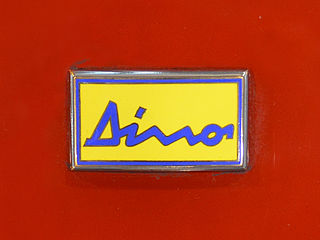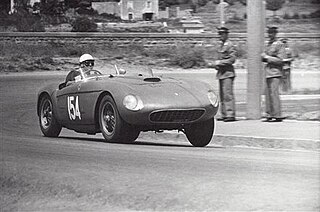
Dino was a marque best known for mid-engined, rear-drive sports cars produced by Ferrari from 1957 to 1976. The marque came into existence in late 1956 with a front-engined Formula Two racer powered by a brand new Dino V6 engine. The name Dino was used for some models with engines smaller than 12 cylinders, it was an attempt by the company to offer a relatively low-cost sports car. The Ferrari name remained reserved for its premium V12 and flat-12 models until 1976, when "Dino" was retired in favour of full Ferrari branding.

A grand tourer (GT) is a type of car that is designed for high speed and long-distance driving due to a combination of performance and luxury attributes. The most common format is a front-engine, rear-wheel-drive two-door coupé with either a two-seat or a 2+2 arrangement. Grand tourers are most often the coupé derivative of luxury saloons or sedans. Many iconic car models, such as the Ferrari 250 GT, Jaguar E-Type, and Aston Martin DB5, are considered classic examples of gran turismo cars.

The Ferrari 250 GTO is a grand tourer produced by Ferrari from 1962 to 1964 for homologation into the FIA's Group 3 Grand Touring Car category. It was powered by Ferrari's Tipo 168/62 Colombo V12 engine. The "250" in its name denotes the displacement in cubic centimeters of each of its cylinders; "GTO" stands for Gran Turismo Omologato, Italian for "Grand Touring Homologated".

The Ferrari 275 is a series of front-engined V12-powered grand touring automobiles with two-seater coupé and spider bodies produced by Ferrari between 1964 and 1968. The first 275 series cars were powered by a 3.3 L (3286 cc) overhead camshaft Colombo 60° V12 engine producing 260–320 hp (190–240 kW). An updated 275 GTB/4 was introduced in 1966, with a revised four overhead camshaft engine producing 300 hp (220 kW). The 275 series were the first road-going Ferraris equipped with a transaxle and independent rear suspension.

The Ferrari 550 Maranello is a front-engine V12 2-seat grand tourer built by Ferrari from 1996 to 2002. The 550 Maranello marked Ferrari's return to a front-engine, rear-wheel drive layout for its 2-seater 12-cylinder model, 23 years after the 365 GTB/4 Daytona had been replaced by the mid-engined Berlinetta Boxer.

The Ferrari 250 is a series of sports cars and grand tourers built by Ferrari from 1952 to 1964. The company's most successful early line, the 250 series includes many variants designed for road use or sports car racing. 250 series cars are characterized by their use of a 3.0 L (2,953 cc) Colombo V12 engine designed by Gioacchino Colombo. They were replaced by the 275 and 330 series cars.
The Ferrari P was a series of Italian sports prototype racing cars produced by Ferrari during the 1960s and early 1970s.

The Ferrari250 Testa Rossa, or 250 TR, is a racing sports car built by Ferrari from 1957 to 1961. It was introduced at the end of the 1957 racing season in response to rule changes that enforced a maximum engine displacement of 3 litres for the 24 Hours of Le Mans and World Sports Car Championship races. The 250 TR was closely related to earlier Ferrari sports cars, sharing many key components with other 250 models and the 500 TR.

The 1963 24 Hours of Le Mans was the 31st Grand Prix of Endurance in the 24 Hours of Le Mans series and took place on 15 and 16 June 1963. It was also the tenth round of the 1963 World Sportscar Championship season.

The 1962 24 Hours of Le Mans was a motor race for Experimental cars and Grand Touring cars, staged at the Circuit de la Sarthe, Le Mans, France on 23 and 24 June 1962. It was the 30th Grand Prix of Endurance and the eighth round of the 1962 International Championship of Manufacturers.

The 1961 24 Hours of Le Mans was a motor race for Sports cars and Grand Touring cars staged at the Circuit de la Sarthe, Le Mans, France on 10 and 11 June 1961. It was the 29th Grand Prix of Endurance and the fourth race of the 1961 World Sportscar Championship. Ferrari and Maserati were the main contenders, with Aston Martin an outside chance.

The 1960 24 Hours of Le Mans was the 28th 24 Hours of Le Mans Grand Prix of Endurance, and took place on 25 and 26 June 1960, on Circuit de la Sarthe. It was the fifth and final round of the F.I.A. World Sports Car Championship as well as being the fifth round of the inaugural FIA GT Cup. It was held just a week after the tragic Belgian F1 GP in which two drivers were killed and Stirling Moss and another driver were seriously injured. The prospect of a duel between the 3-litre (180 cu in) Ferrari versus the 2-litre (120 cu in) Porsche championship-leaders was enough to draw large crowds to the 24 Hours race and some 200,000 spectators had gathered for Europe's classic sports car race, around the 13.5 km (8.4 mi) course.

Medardo Fantuzzi (1906–1986) was an Italian automotive engineer, known for his Carrozzeria Fantuzzi body workshop.

The Ferrari 250 S was a sports racing car produced by Ferrari in 1952. It was the first in the long lineage of Ferrari 250 road and race cars powered by a ubiquitous 3.0-litre Colombo V12 engine. In 1952 the 250 S won the Mille Miglia and 12 Hours of Pescara. At the Le Mans, the same year, it clocked the fastest race lap time. Only a single example was produced.

The Ferrari Monza is one of a series of cars built by Ferrari. In the early 1950s, Ferrari shifted from using the compact Gioacchino Colombo-designed V12 engine in its smallest class of sports racers to a line of four-cylinder engines designed by Aurelio Lampredi. Inspired by the success of the light and reliable 2.5 L 553 F1 car, the four-cylinder sports racers competed successfully through the late 1950s, culminating with the famed 500 Mondial and 750 Monza.

The Ferrari 250 Monza was a sports racing car produced by Ferrari in 1954. It was a combination of a stretched chassis and body from the line of inline-four-engined racers with an ubiquitous 3.0-litre Colombo V12 engine.

The Ferrari 335 S was a sports racing car produced by Italian manufacturer Ferrari in 1957. The car was a direct response to the Maserati 450S which with its 4.5-litre engine was threatening to overpower the 3.8-litre 315 S and 3.5-litre 290 MM. Four cars were produced in total.
Neri and Bonacini, also known as Nembo, was a small carrozzeria and mechanic shop based in Modena, Italy, active from the late 1950s to around 1967. Founded and run by Giorgio Neri and Luciano Bonacini, the shop worked on and produced bodies for Ferrari, Lamborghini and Maserati road and race cars, both in an official capacity for those manufacturers and for private owners. Their best known projects are the Ferrari 250 GT-based Nembo spiders and the Lamborghini 400GT Monza. Neri and Bonacini also designed a car under their own name, the Neri and Bonacini Studio GT Due Litri. Two prototypes of this car were made between 1966 and 1968 but it never entered series production. The shop closed around 1967 when Bonacini went to work for De Tomaso and Neri started his own shop, Motors-World-Machines (MWM).

The Ferrari 735 LM was a sports racing car produced by Ferrari in 1955. It was the second raced Ferrari, powered by an Aurelio Lampredi-designed inline-6 engine, created as a larger displacement evolution to the engines used in the Ferrari Monza race cars.

The Ferrari SP was a series of Italian sports prototype racing cars produced by Ferrari during the early 1960s. All featured a rear mid-engine layout, a first for a Ferrari sports car. Major racing accolades include the 1962 European Hill Climb Championship, two overall Targa Florio victories, in 1961 and 1962, and "1962 Coupe des Sports" title.



















